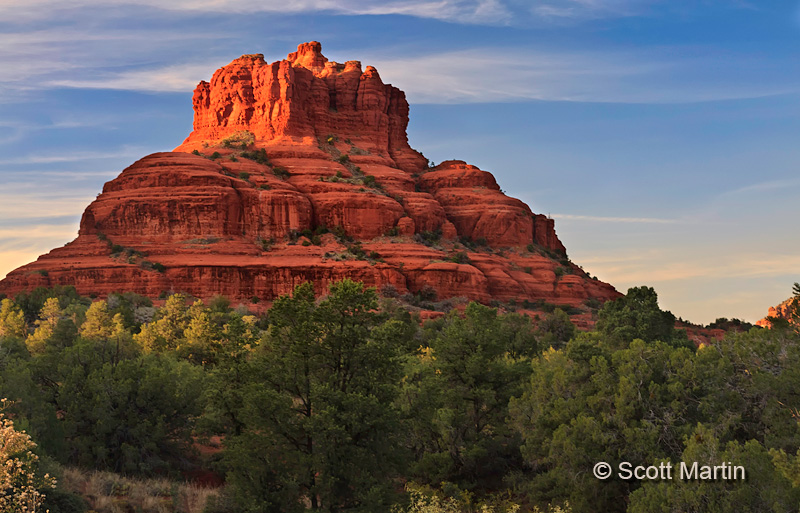
by Scott Martin Photography | Feb 21, 2012 | Blog
Photographers in general and landscape photographers specifically take most of their images in the early morning or late afternoon light. These times, for an hour or two after sunrise and the same before sunset are often referred to as the “Golden Hours”. When the sun is close to the horizon, the incident light travels farther through the atmosphere and more of it is refracted or scattered, losing some of the higher wavelengths (blues) leaving the lower wavelengths (reds) creating the typical pinkish sunrises and red/orange sunsets we enjoy so much. Also during the golden hours, the shadows are longer, the light is more even and the lighting ratios are reduced all of which combine for the great light which makes every image better than when shot in the harsher direct light of the mid-day.
The images in this post are taken in Sedona Arizona, which is located about two hours north of Phoenix Arizona and it’s where Deb & spent the first night of our five-day photo tour of the Grand Canyon area. Sedona is an absolutely beautiful town and the scenery is spectacular in all directions.
The five images are shown in chronological order, the first two being snap shots taken at the side of the road (Route 179) as we entered Sedona.

.
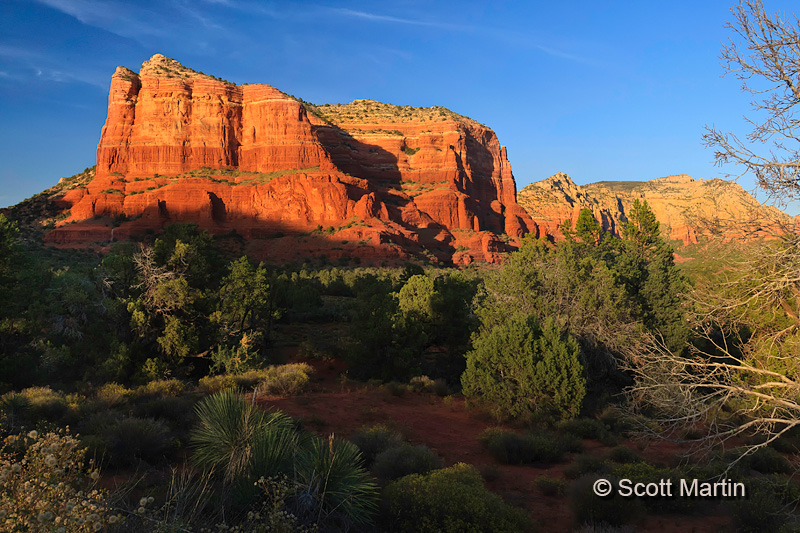
The next three sunset shots mark the transition from the golden hour to twilight. Twilight being the time between sunset and dusk when although the sun is below the horizon the sky retains its blue colour to the eye before transitioning to the blackness of night. “Night” photography should always be done during twilight while the sky retains some colour which serves to preserve the distinction between the objects and the sky. Once the sky is dark the boundary between the object and the background is lost resulting in a poor image.
The following images were taken from the top of Airport Road which climbs to a vantage point high above Sedona and is a popular place for people to gather and watch the spectacular sunsets. There were probably a hundred people there the evening we were including a number of serious photographers jostling for the best spot to set up a tripod. They were taken with a 16-35/2.8 zoom lens using Lee & Singh-Ray 4×6 ND gradient filters.
This next image is a favourite, taken just before sunset, and I wish you could see it full size. Our first night in Arizona was the only day we saw clouds in the sky.
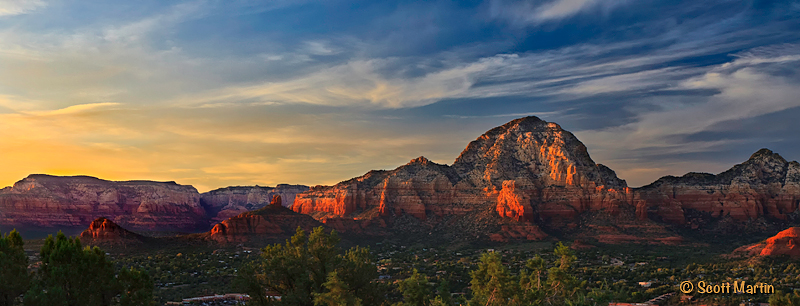
The next image was taken after sunset and by using a longer exposure captured more colour (reds/pinks) than would be seen while watching the sunset.
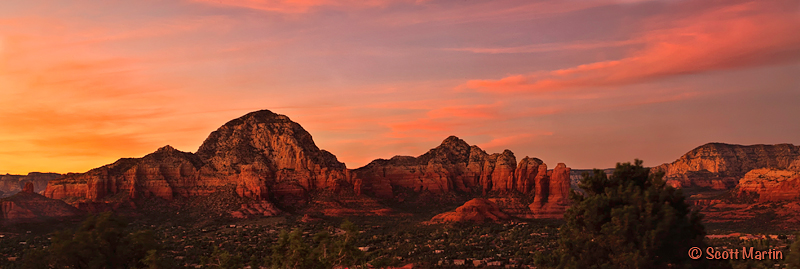
This last image was taken long after sunset when it was almost dark as you can tell by the lights in the Sedona Streets in the foreground. As in the previous image, an overly long exposure was used to get some light in the sky, which would have appeared almost dark when taking the photograph.
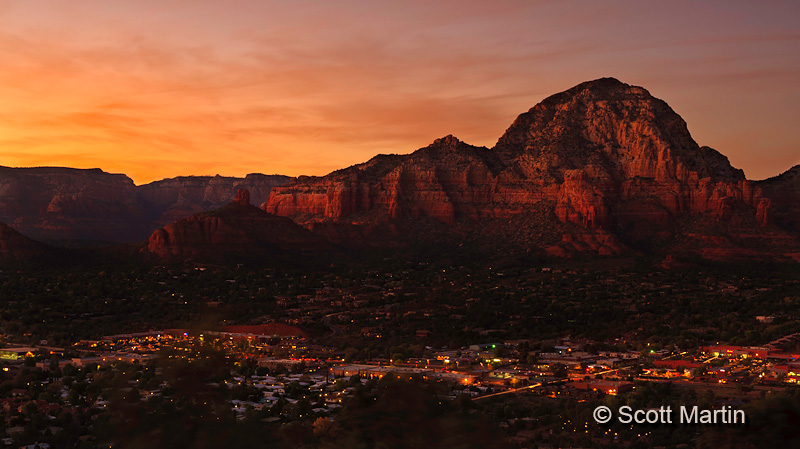
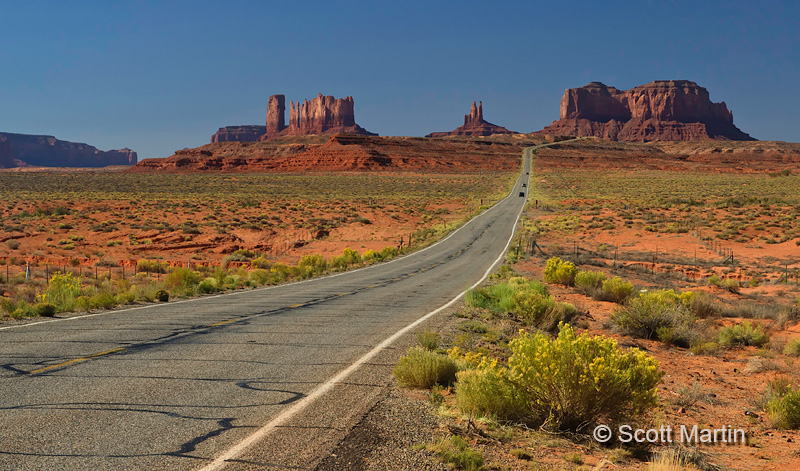
by Scott Martin Photography | Feb 17, 2012 | Blog, Landscapes, Naturescapes, Travel
Heading southwest towards Monument Valley on Route 163 near the Utah Arizona border you are greeted by one of the most iconic open road views in the country. Our first glimpse of this amazing vista was in the rear view mirror as we were heading North towards Moab at the time! No doubt you have seen pictures similar to the ones posted today, however I trust you also enjoy these. Please feel free to comment on them and let me know which perspectives you enjoy the best.
The five images to follow were all taken hand-held at focal lengths ranging from 16-105 mm, with the perception of the depth of the image being progressively compressed at the focal length increases. One of the ‘rules’ of wide-angle landscape photography is to have something of interest in both the foreground and background , however this creates a problem for shots like these where the topography is pretty nondescript save for the incredible buttes and mittens that are at least five miles away. To try to follow the rules of composition, I found the largest bush along the road side and positioned it in the foreground of the image, making sure to have the camera high enough that separation was maintained between the bush and the background rock formation.

This next shot was taken from the same general spot as the first image (you can see the bush used as foreground object in the last shot on the right side of this image as well). The only differences being focal length (24mm) and lower camera height to change the perspective making the road more prominant. For this shot I was lying down so the camera was only about six inches above the road. This image is a single frame, cropped to create the panoramic look.

The last three images attempt to find a pleasing balance of perspective and composition resulting in a great photograph, or moving the image from a snapshot to a photograph.
The next image is just a snapshot, taken with the camera at standing height from relatively close to the rock formation. Being too close to the background stops the road from disappearing into a long thin ribbon which takes a way the feeling of great distances and also reduces the ability to sense just how big the rock formations actually are. Both of these problems are compounded by the longer focal length chosen to take the image (105 mm).
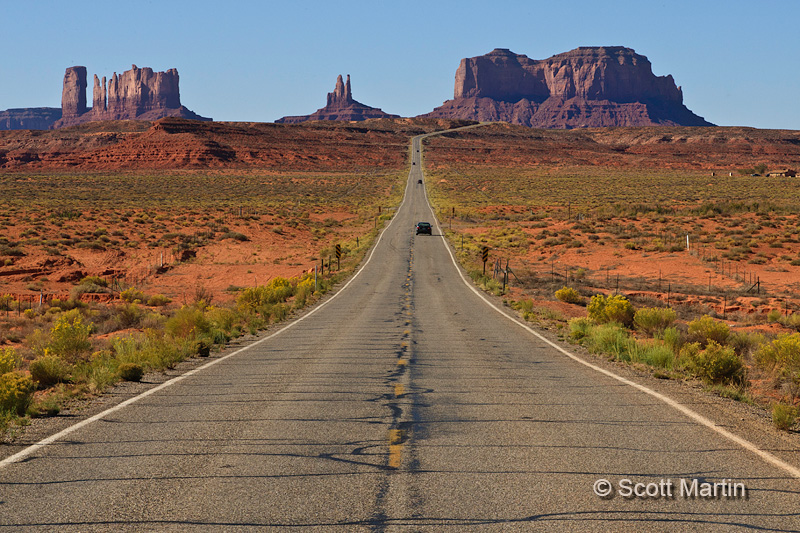
The last two shots come the closest to working well at conveying the feeling of what it was like to actually be there. The next image was taken from the farthest point away from the buttes which were about four or five kilometres away. It was taken standing to reduce the relative size of the road in the foreground and including a bend in the road to change the way your eyes are led towards the buttes and mittens in the background.
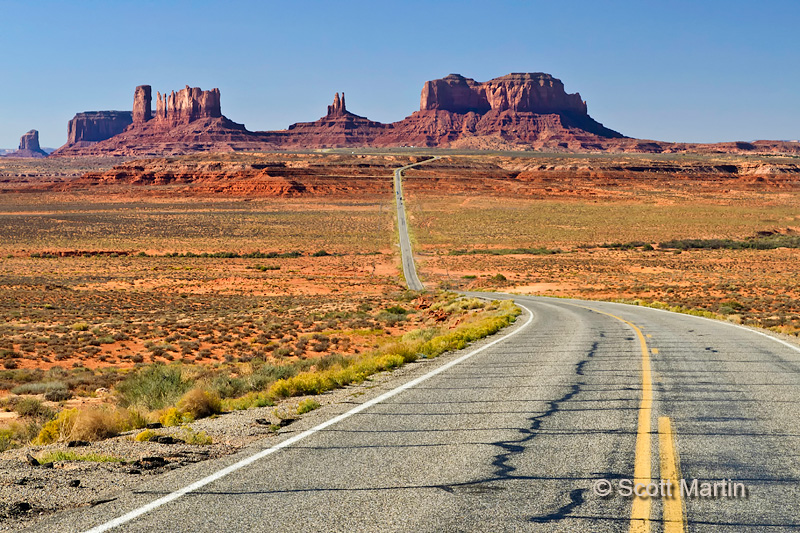
The last image is my favourite of this group. It was taken from a sitting position in the middle of the road to enlarge the presence of the road slightly as well as allowing the small berms on the roadside to provide some foreground interest. Plus the straight road into Monument Valley takes you immediately to the object of the image. The shot was taken at 65mm at f/16 at 1/100 sec.
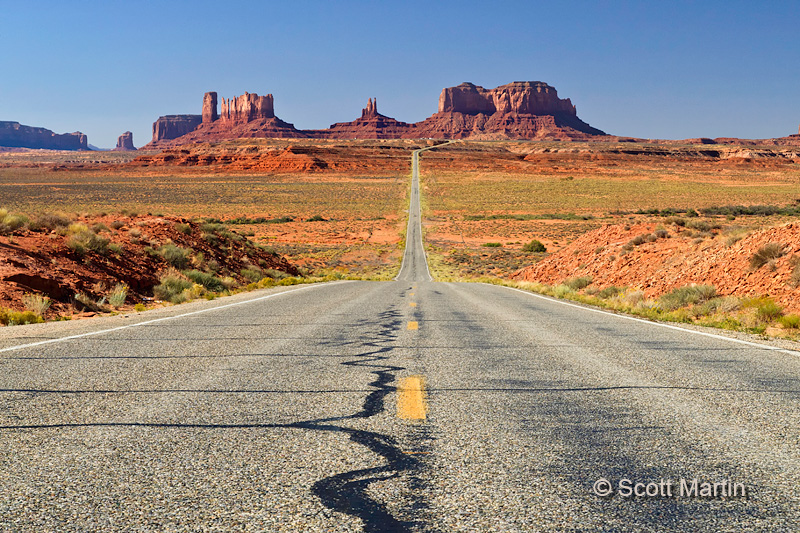
The enjoyment of an image is a purely subjective thing, we either like it, don’t like it or are ambivalent towards it. The trick with good photography is to deliver images that someone other than yourself actually likes! To do that we need to learn to always be thinking about the pictures we are taking, and then experimenting with different variations of the same scene like I’ve tried to demonstrate with these images of Monument Valley. The more thought one puts into the exercise before pressing the shutter really helps deliver consistently better images. It is so much easier to improve your skills in the digital age as CF cards are inexpensive and we can take lots of images in order to arrive at a couple of good ones. For this series Deb & I probably spent an hour or so stopping at four or five different spots along the highway and taking about seventy-five images.
If you haven’t already been there, plan a trip to Monument Valley. You will be glad you did!
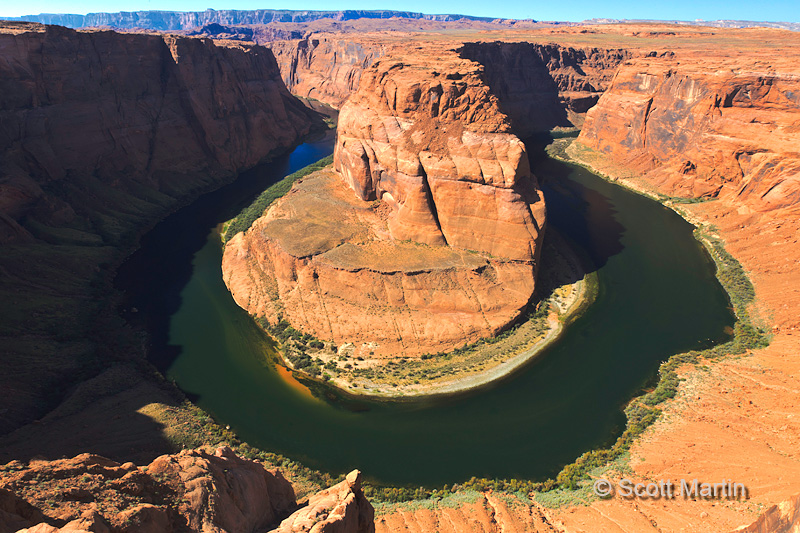
by Scott Martin Photography | Feb 11, 2012 | Blog, Landscapes, Naturescapes, Travel
The Horseshoe bend in the Colorado River is located just outside of Page Arizona just west of Highway 89. It is one of the most impressive vistas along the river and has become an iconic image of the Grand Canyon area. The Bend is reached by a rather short trail of three quarters of a mile, however the soft sand over most of the trail makes for a rather arduous trek and there is absolutely no shelter from the sun, so remember to take lots of water with you.

Taking a good picture of the bend is not done without a little fear and trepidation as the rim is over 1000 feet above the river and in order to keep the entire river in the frame the camera needs to be right on the brink. I set my tripod up as low as possible and crawled the last few feet to the brink on all fours. Once you peak your head over the edge its an awe-inspiring sight; Gods great handiwork right before for eyes! The image above was taken at a focal length of 16mm and is a single image. I have a number of panoramic images of the area which I may post later.
A couple of miles upstream from the Horseshoe bend is the Glen Canyon Dam, which is bigger than its more famous down stream cousin, the Hoover Dam, located just outside Las Vegas, Nevada. The Glen Canyon Dam is 710′ high and 1560′ wide and over 300′ thick at the base. The reservoir it created is Lake Powell, the second largest artificial lake in the States.
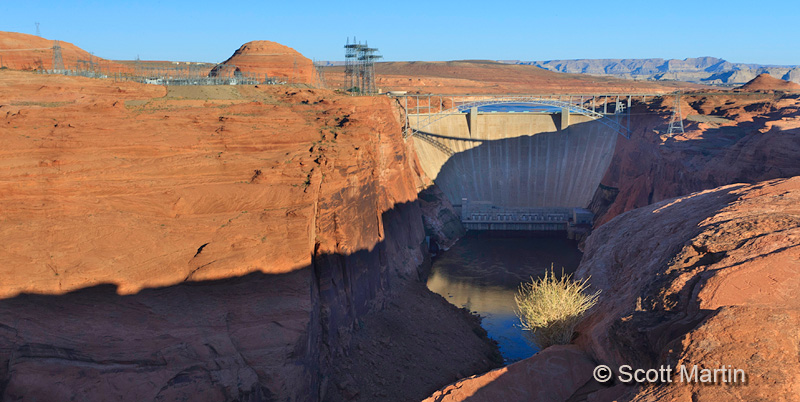
The Glen Canyon Dam was constructed between 1956-1966 while the Hoover Dam was built from 1931-1936.
We were visiting the dam mid-morning after hiking to the Horseshoe bend for sunrise. This created strong shadows across the face of the dam which results in poor images, however here is an attempt to make an artistic shot of a hydroelectric dam.
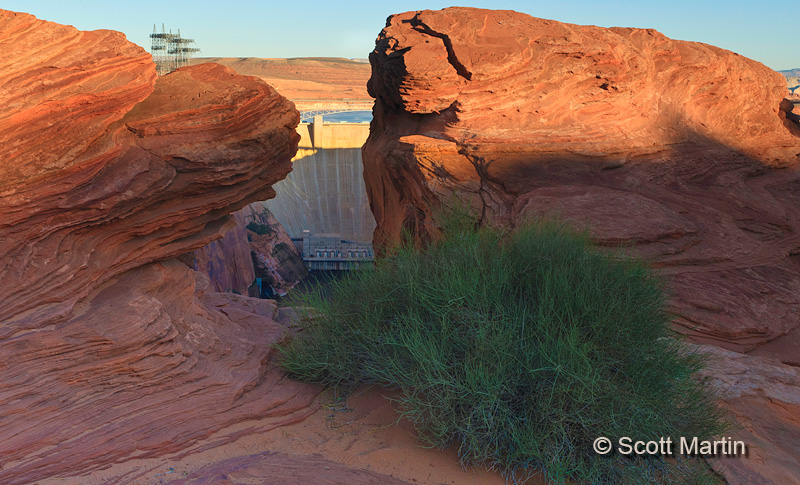
Page AZ is also known for the Antelope Slot Canyons, which are a must see when in the area.
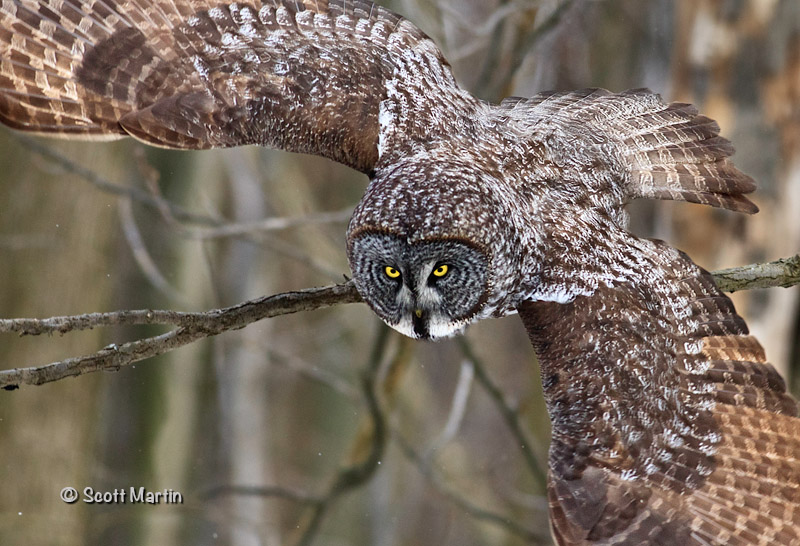
by Scott Martin Photography | Jan 24, 2012 | Birds, Blog, Raptors
Recently I posted an image of a Great Gray Owl that showed up in Kingsville Ontario (on the shores of Lake Erie between Point Peele and Windsor) which is very unusual. The Great Gray Owl is a northern bird and although common in Northern Ontario they are rarely seen south of Timmins. This particular owl arrived in Kingsville before Christmas and was seen almost daily until a couple of weeks ago so perhaps it has started to head back north. It was certainly a local celebrity and even made the front page of the Sunday edition of the Toronto Star
The Great Gray Owl is North America’s largest owl with a length of almost three feet and wing span of five feet. It is a beautiful collection of gray, brown and white colours with a large and interesting head which lacks ear tuffs, has brilliant yellow eyes that are relatively small compared to the other owls and sports a white moustache. Although the Great Gray is the largest owl, it is not the heaviest. The Great Horned Owl enjoys that distinction. Owls are raptors and the Great Gray Owl’s diet consists primarily of Ptarmigan in the north, however when poor food supply in the north forces the owls into more southern areas they feed primarily on voles, mice and perhaps chipmunks or squirrels.
I was fortunate to be able to take some flight shots of the Great Gray Owl. This first image was taken when the owl launched while I was photographing with a 500mm lens from a distance too close to keep the wings in the frame. Although clipping the wings in flight shots is a bit of a “no no” the intensity of the eyes in this shot was enough that I just couldn’t delete the image.

The next two images were taken with a 70-200 f/2.8 L IS zoom lens which is a fairly fast focussing lens needed to track birds while flying. It’s an amazing technology that allows the camera to “lock on” to a moving object and continually keep it in focus while taking about ten frames per second. In these images you can easily see the intensity of the eyes as they lock on to the prey.
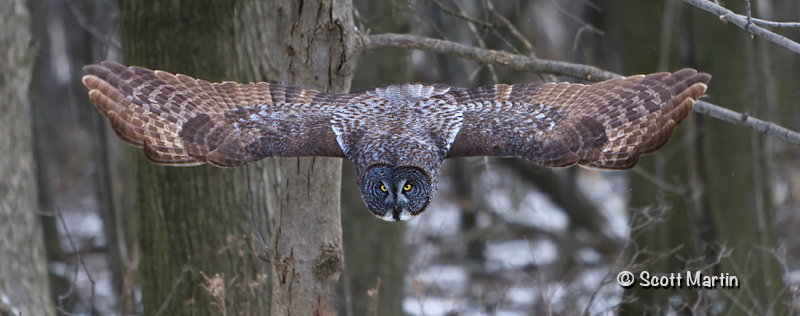
.
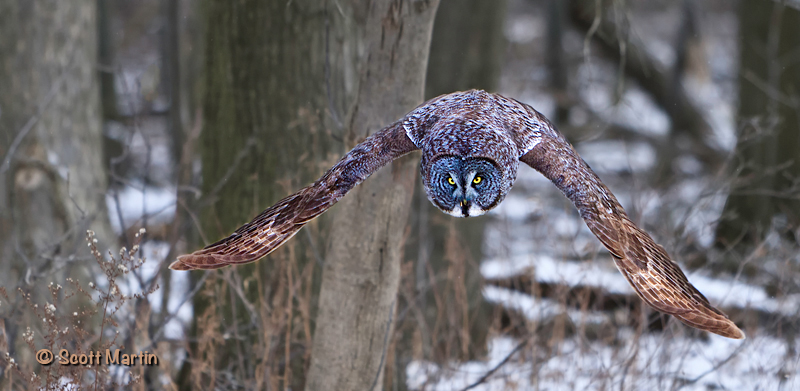
The face of an owl is rarely seen as we don’t often get a chance to be close enough to witness the amazing details it contains. This close up portrait was taken with a 700mm focal length lens from about thirty feet away from the owl.
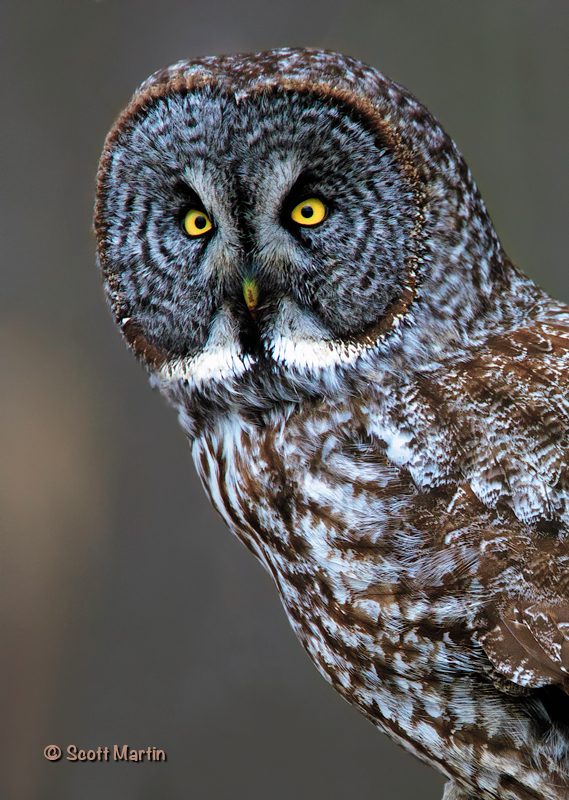
And finally a portrait showing the Owl in its more natural habitat, the snowy winter climate of the Canadian North…..I just wish the flakes were a little larger, but it only snowed for about five minutes over the course of the day I was there.
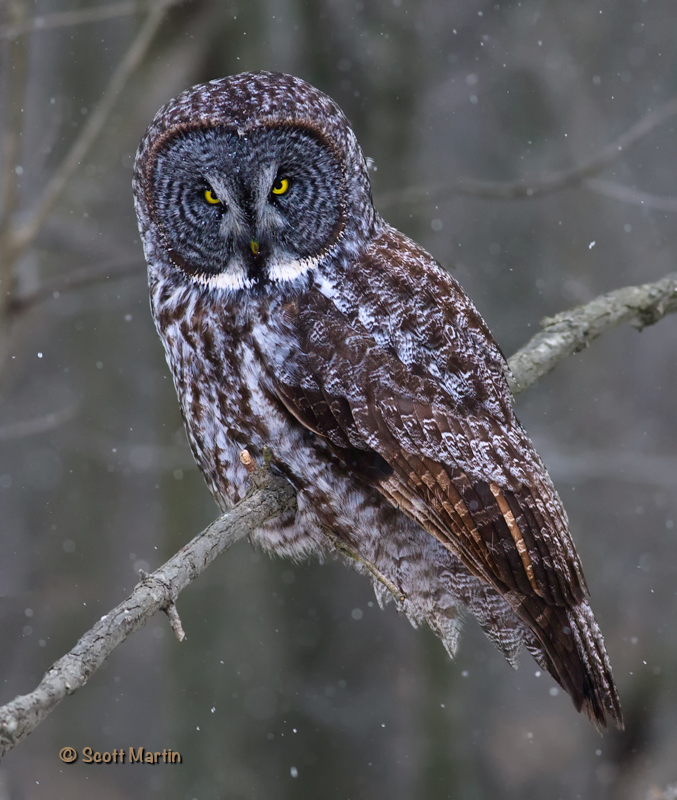
I trust you enjoyed these images of the Great Gray Owl and if ever you hear about one in your area make sure make an effort to get out and see it. You will be glad you did! To see more owl images please click here to visit my gallery.
Please feel free to leave comments or ask any photography questions you may have regarding the posted images. I would be honoured to hear from you and answer your questions.
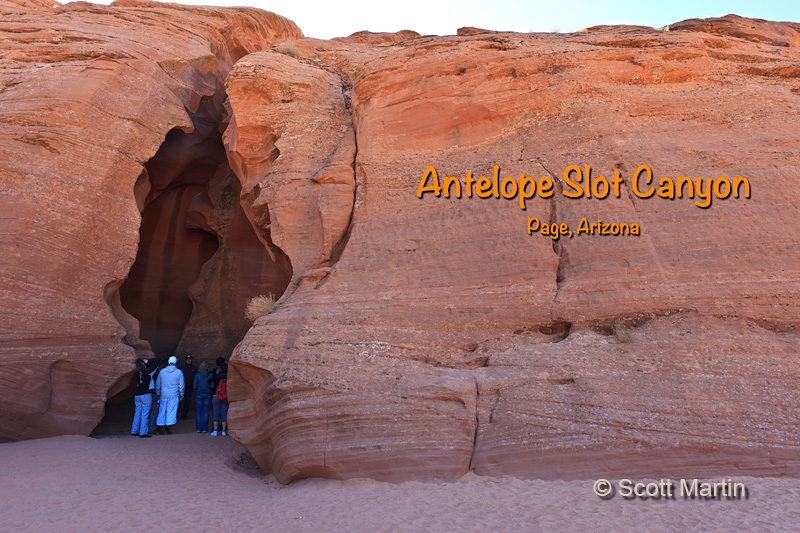
by Scott Martin Photography | Jan 14, 2012 | Blog, Landscapes, Naturescapes, Travel
The Antelope Slot Canyons, located on Navajo lands just outside Page Arizona are arguably the most famous and picturesque slot canyons in the world. The canyons are accessible only with a Navajo guide and a specialized 4×4 truck transports you the last couple of miles from the nearest road to the canyon entrance. We used the services of Caroline Ekis who owns and operates Antelope Canyon Tours. They have dedicated photography tours which limits the number of participants to eight at a time which makes it a bit easier to set up gear, however many other tour groups are also in the canyon at the same time so the biggest challenge is getting a shot without someone walking in front of the camera during the 20-30 second time exposures required in the canyon.

.
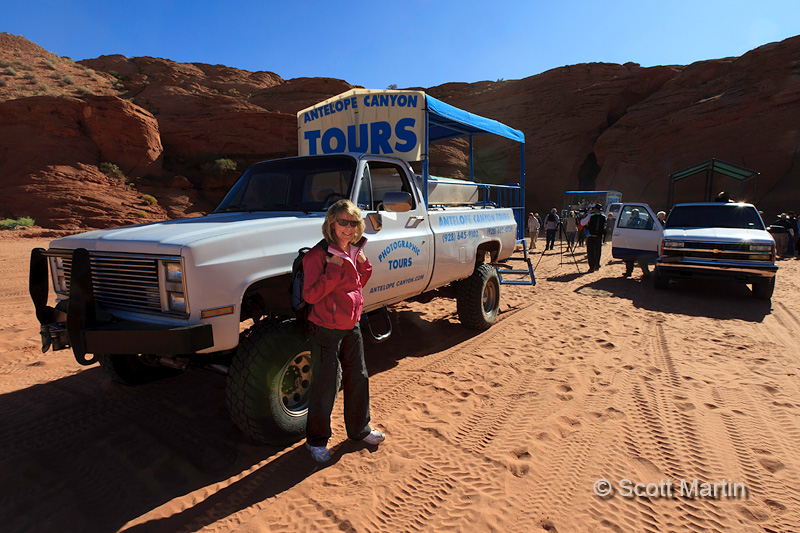
There are two Antelope canyons, the upper canyon which the one we visited and the lower canyon which is close by however requires one to climb down steep stairways to enter and leave the canyon. The slot canyons are formed when flash floods caused by rain storms during monsoon season rush through the sandstone mesas and literally carve the slots through the sandstone. Once the slot is formed, subsequent flooding travels through the same path making the slots deepen over time. Presently the Antelope Slot Canyons range up to 120 feet deep. The Upper Canyon is a little over 1/4 mile long and ranges in width at the bottom from less than three feet to fifteen or twenty feet in some places. If you are interested in more information on the canyons, here is a link to the Wikipedia Antelope Canyon site.
Photographically its a challenge in the canyon for a number of reasons, low available light necessities long exposures and good low light techniques (especially at the low ISO’s and small apertures required to minimize noise and maximize depth of field); the tall yet narrow slot requires a wide-angle lens (I used a 16-35mm lens 95% of the time); the EV variation between the top and bottom of the canyon makes exposure bracketing and the use of ND grad filters mandatory; avoiding people and protecting your tripod from getting bumped during exposure was a constant challenge.
Below are some images taken during the two hours we were allowed to remain in the canyon. The first is the entrance way where there is still lots of light.
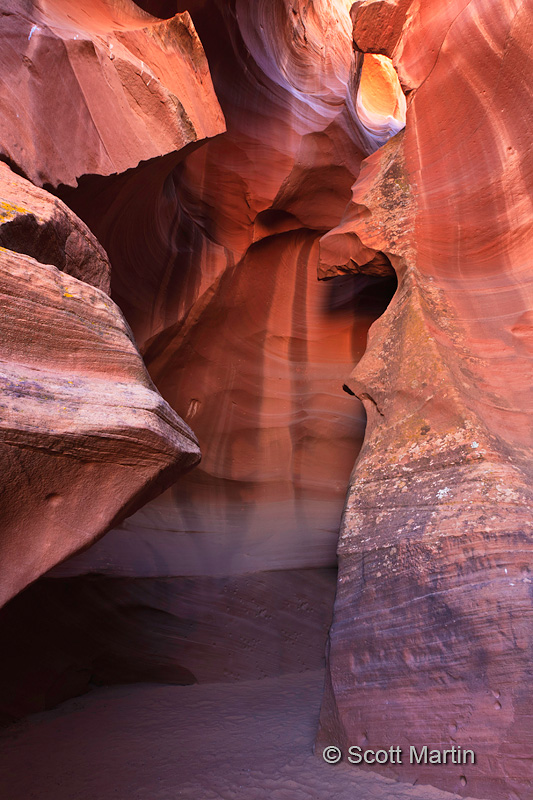
.
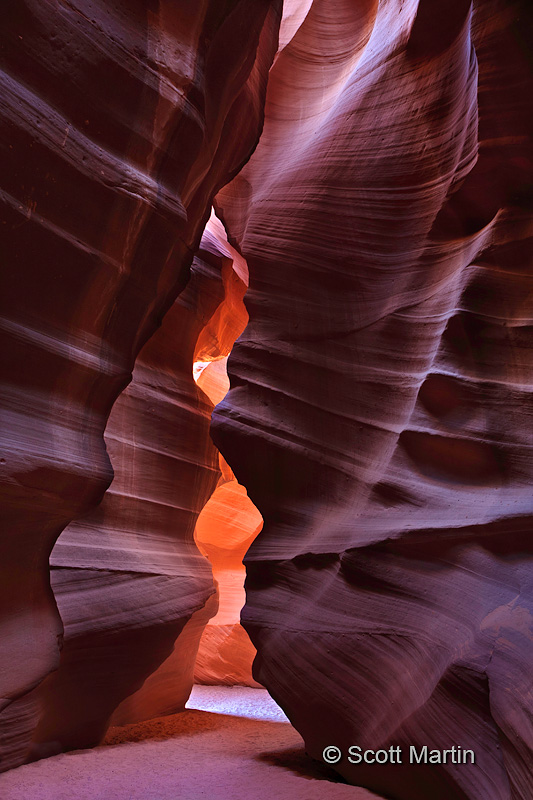
.
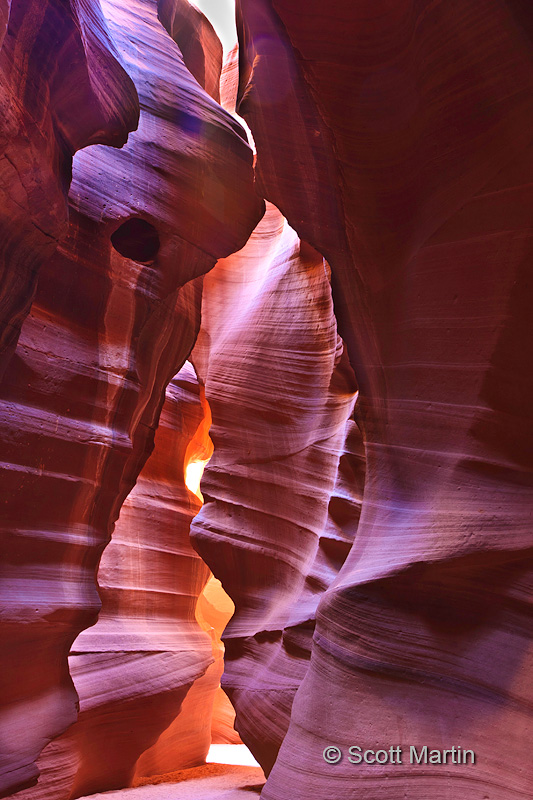
.
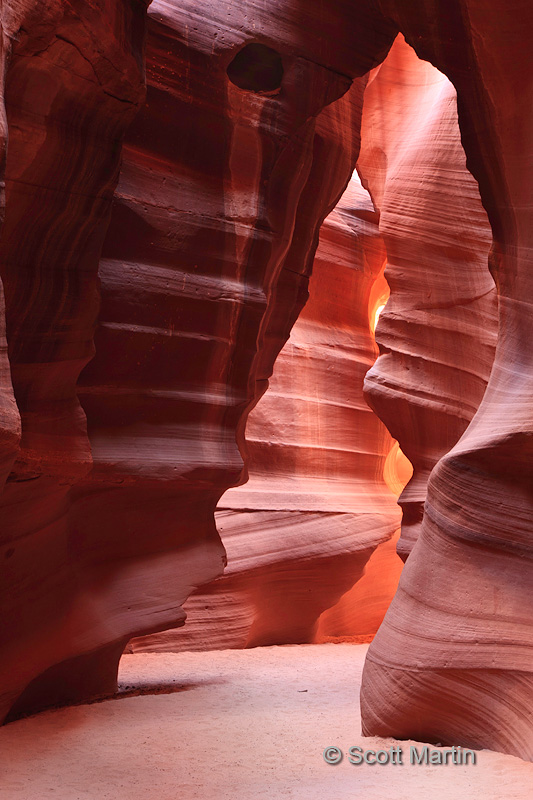
.
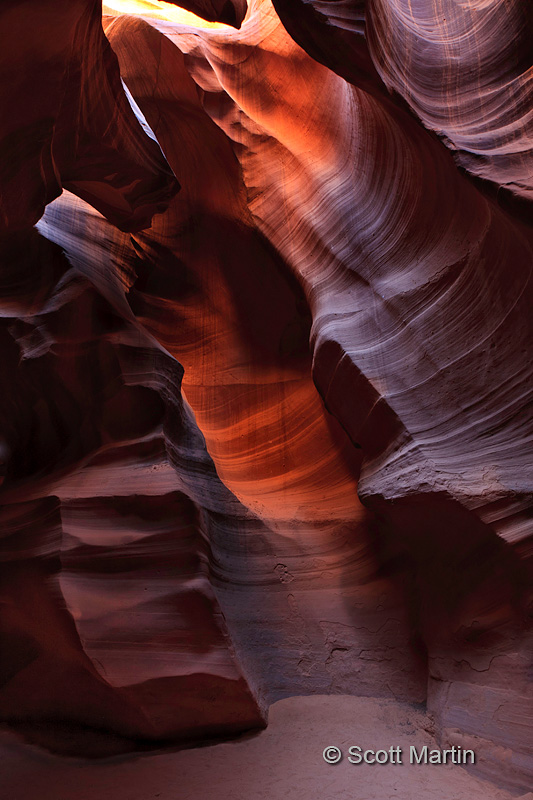
.
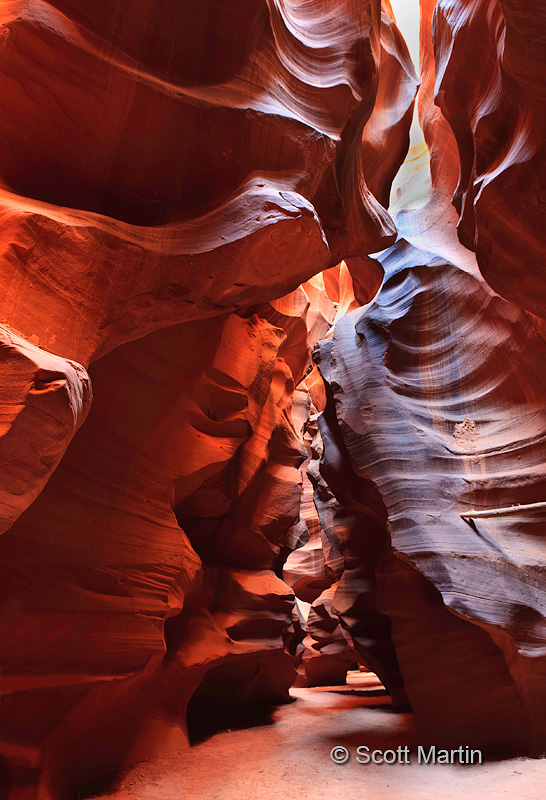
The stick on the right of the image below would have been deposited when the last storm waters moved through the canyon.
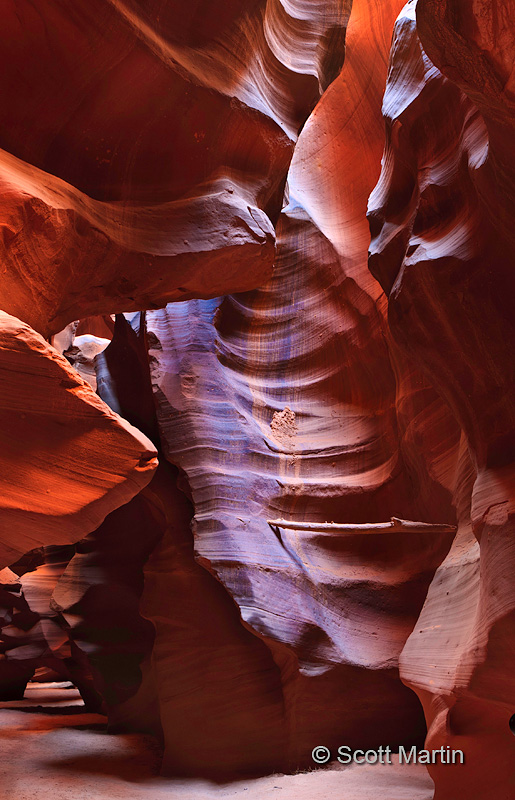
.
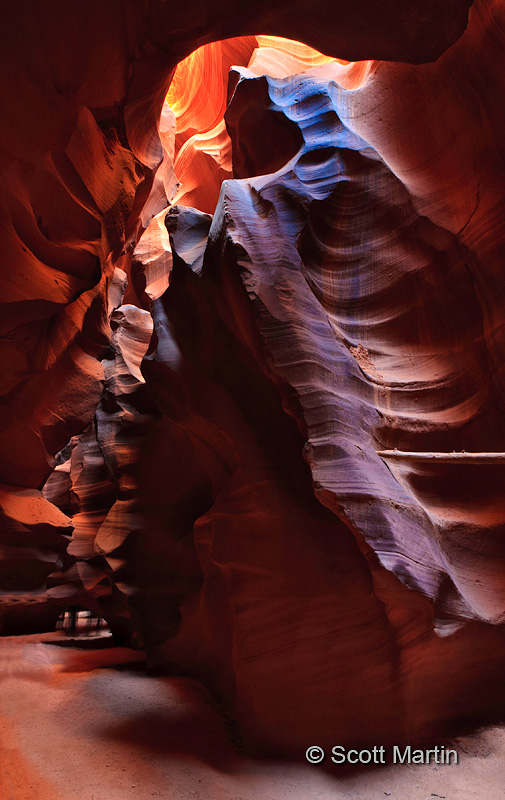
.
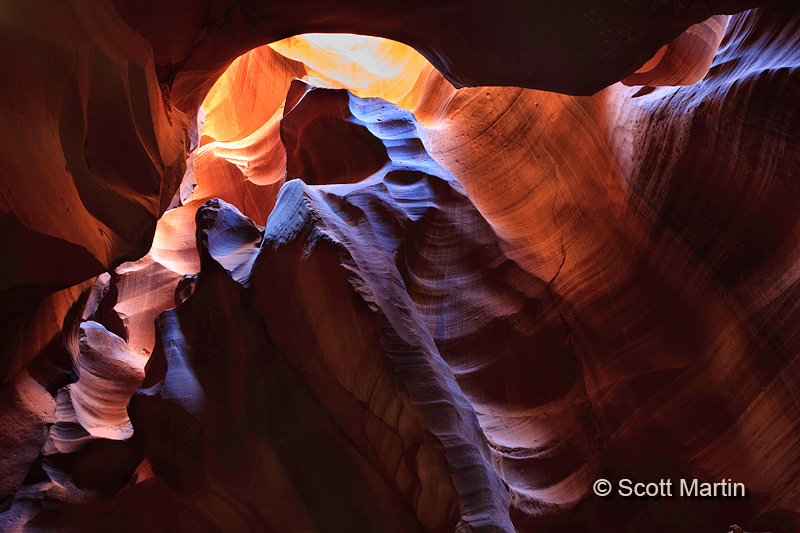
.
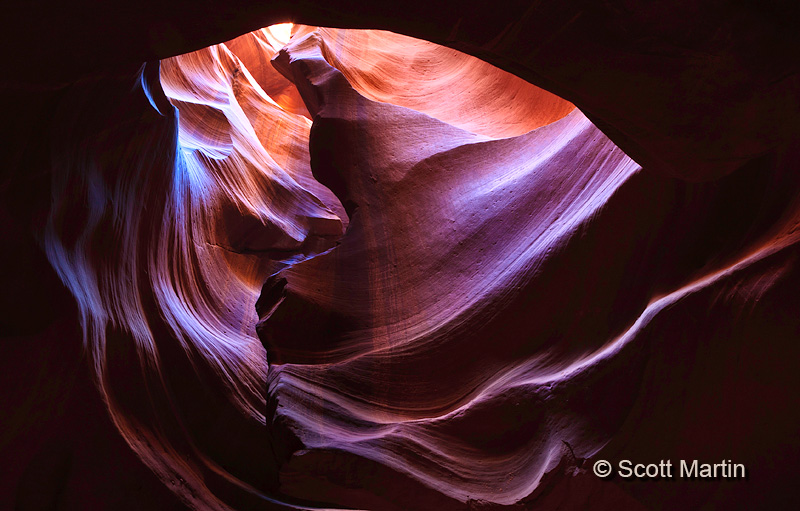
.
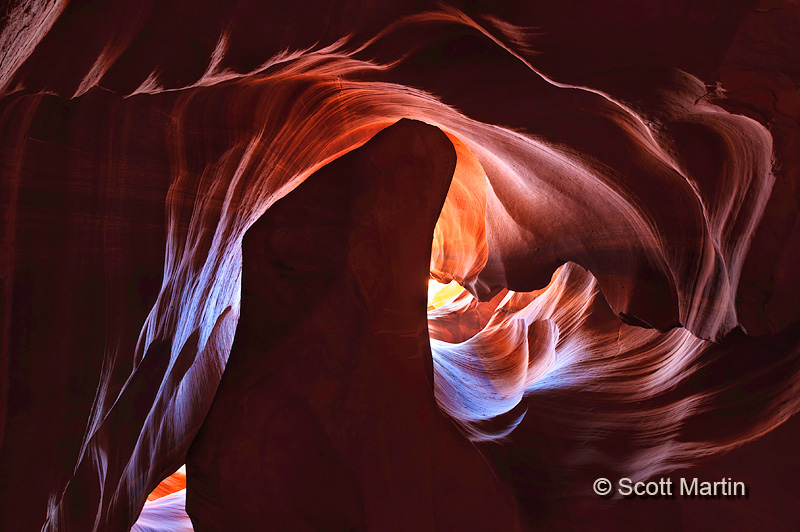
This next image is of the Antelope Canyon waterfall which is created by throwing a huge handful of sand on the rock wall and taking advantage of the long time exposure to create the waterfall effect.

The next few images are my attempt to be creative, which is always a challenge. The following two images are the same except for the exposure time is much less in the first therefore bringing out the deep blues and violets in the rocks.
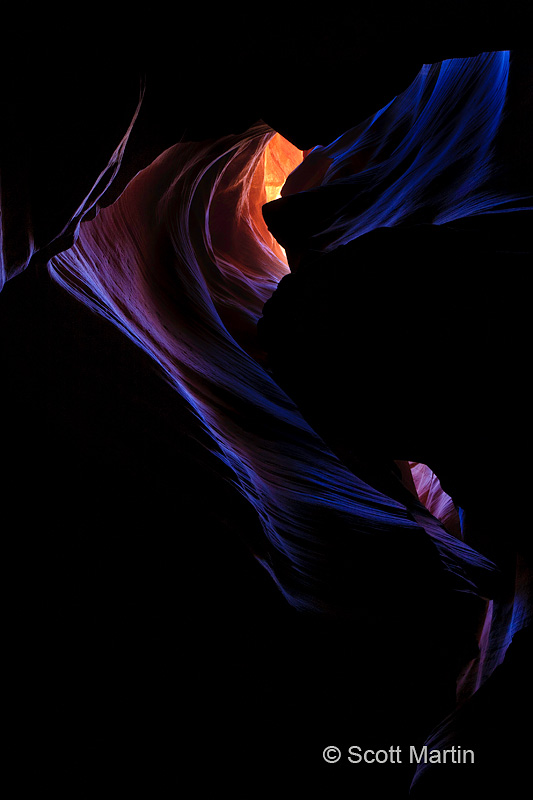
.
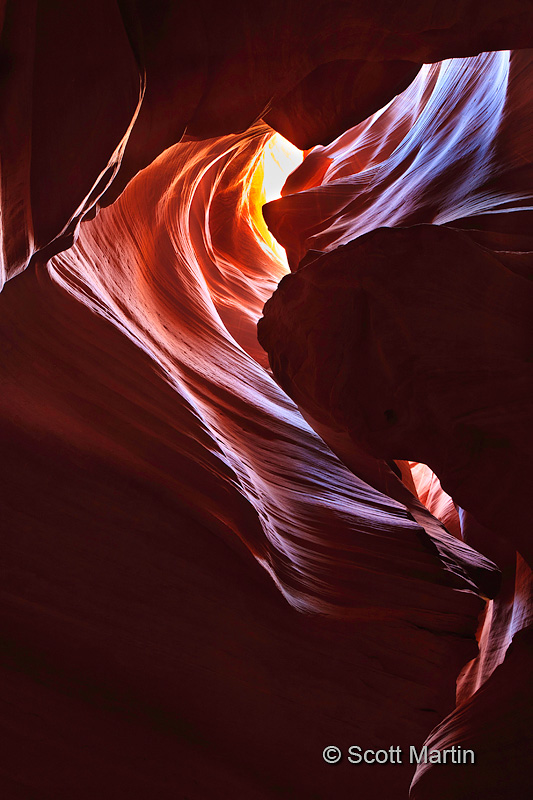
.
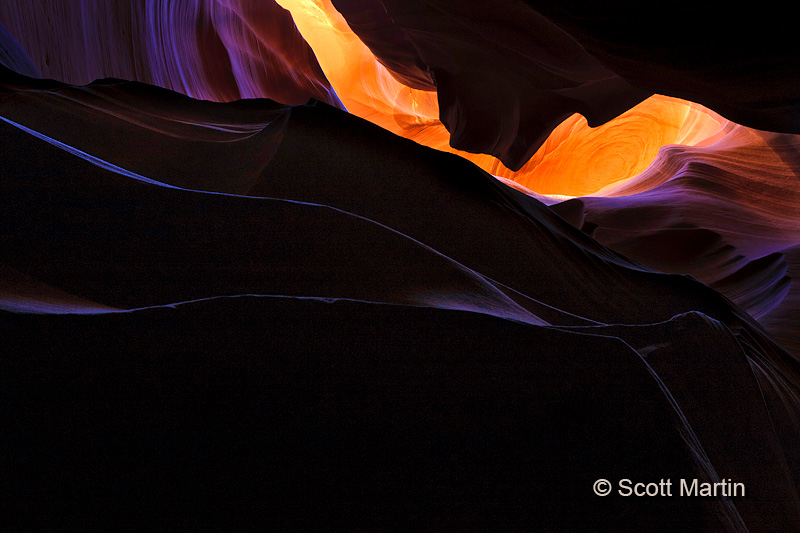
This last shot is the far end of the slot canyon. It took almost two hours to work our way from one end to the other and about ten minutes to rush back through the slot and back to the truck.
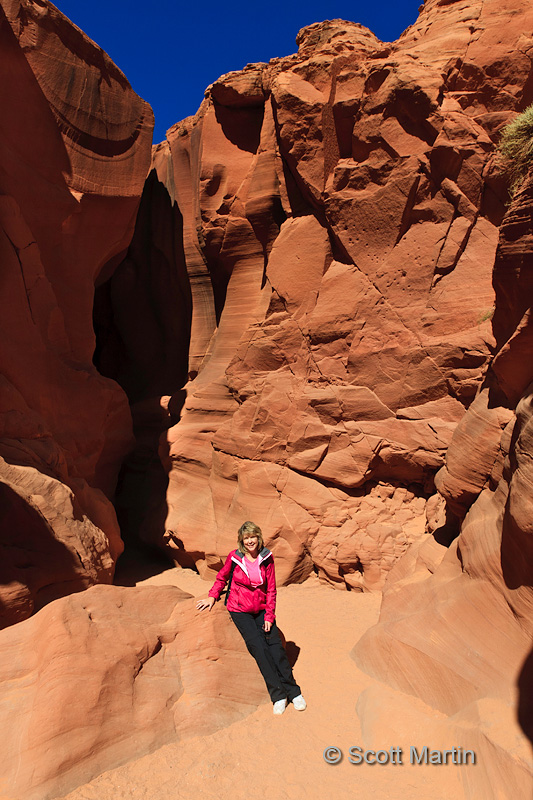
These images and a few more can be seen in the Antelope Canyon Gallery
After leaving the Antelope Canyon we travelled about ten miles to the famous Horseshoe Bend in the Colorado River which will be the focus of an upcoming blog entry.
Visiting the Antelope Slot Canyons was a fantastic experience and I would highly recommend that the next time you are in the vicinity of the Grand Canyon you make it a point to visit Page. Page Arizona is in the north central part of the state and is about a four drive from either Phoenix or Las Vegas.
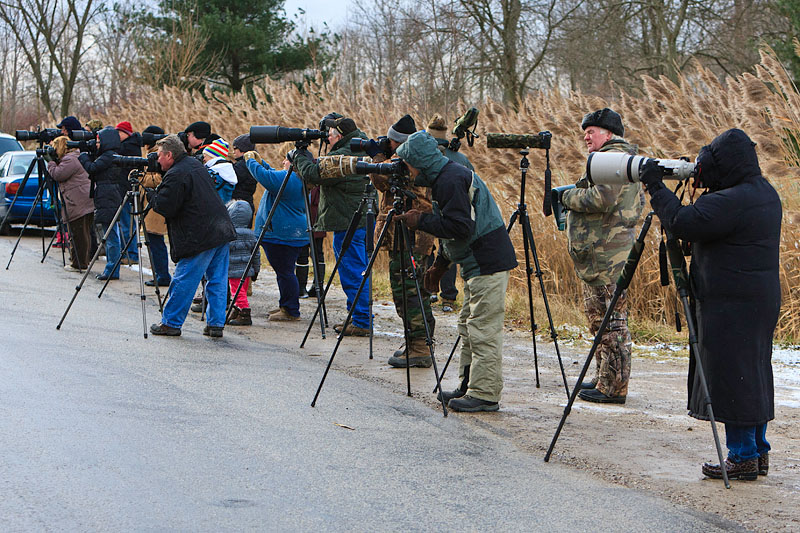
by Scott Martin Photography | Jan 6, 2012 | Birds, Blog, Raptors
Not surprisingly a Great Gray Owl created a big stir this winter when it showed up in Kingsville, Ontario (a small town on the north shore of Lake Erie between Point Peele & Windsor, Ontario) and many people have made the effort to travel great distances to see it. From Oshawa, it was an almost five-hour drive that I was able to make this past Monday and it was a great relief to be able to find the owl after driving all that way! As you can see many other people also wanted to see this magnificent owl.

Although the Owl was pretty much oblivious to the people around, the birders and photographers were very respectful of it and positioned themselves on the other side of the road from the owl as you can see from the above image. This allowed the owl to hunt without distraction or obstruction.
The processing of images from Monday will be an ongoing project and I’ll post some as they get done in the next few weeks. It was an interesting day photographing the Great Gray Owl with everything from an iPhone to 24-105, 70-200, 400, 500 & 700 focal length lenses.
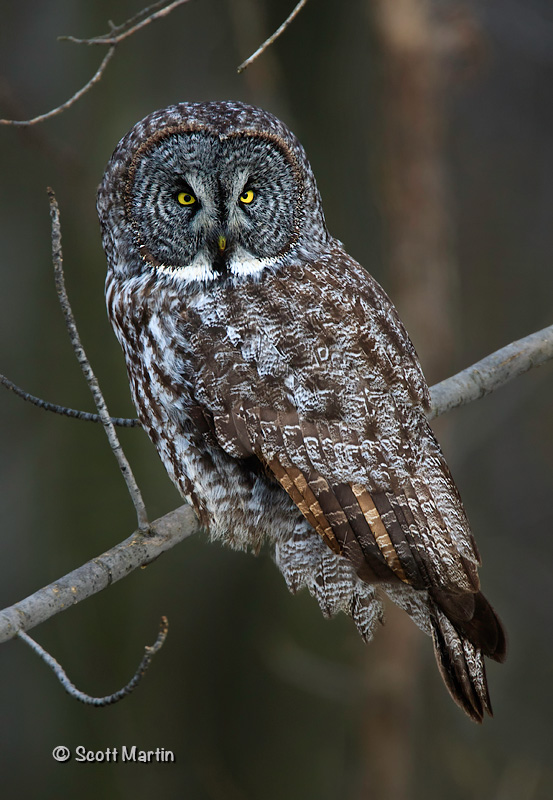













































Follow Scott Martin Photography